“I swear you’ll never see anything like this ever again”. The words of Martin Tyler as he watched in disbelief as Sergio Agüero scored in Fergie time to clinch Manchester City’s EPL title back in 2012. This isn’t the only closely contested title race that has cemented England’s top tier to be one of the most exciting divisions in the world.
City and Liverpool have taken over in recent seasons from the fierce Manchester United and Arsenal rivalry from the late 90s and early noughties. Leicester had a fairytale ending in 2016, and who can forget Kevin Keegan’s “I will love it” rant as his Newcastle side eventually succumbed to United in the battle for the top spot in 1996.
Each title race has a uniqueness to it, and this season is proving to be no different as, at the time of writing, only five points separate Liverpool at the top from fourth-placed Aston Villa. The red half of Merseyside will undoubtedly be looking to give Jürgen Klopp a memorable send-off; City are vying to be the first club to win four consecutive Premier League titles. Arsenal are hoping for a first title since the 2004 Invincibles and Villa are currently surprise contenders under Unai Emery.
In this data analysis, we will assess all four contenders’ seasons to date as well as provide an analysis of their current form to see how this stacks up against previous champions. We will also use our data and statistics assess the nature of when these four sides are scoring goals, as well as identify which players are likely to prove key and how such players fit into their respective sides’ tactics.
Lucky Villa?
Based on recent seasons, it is no surprise to see City, Liverpool, and Arsenal – who occupied pole position for 248 days to no avail last season – are currently vying for the top spot this campaign. However, Villa are certainly the surprise package to date but is it by fluke?
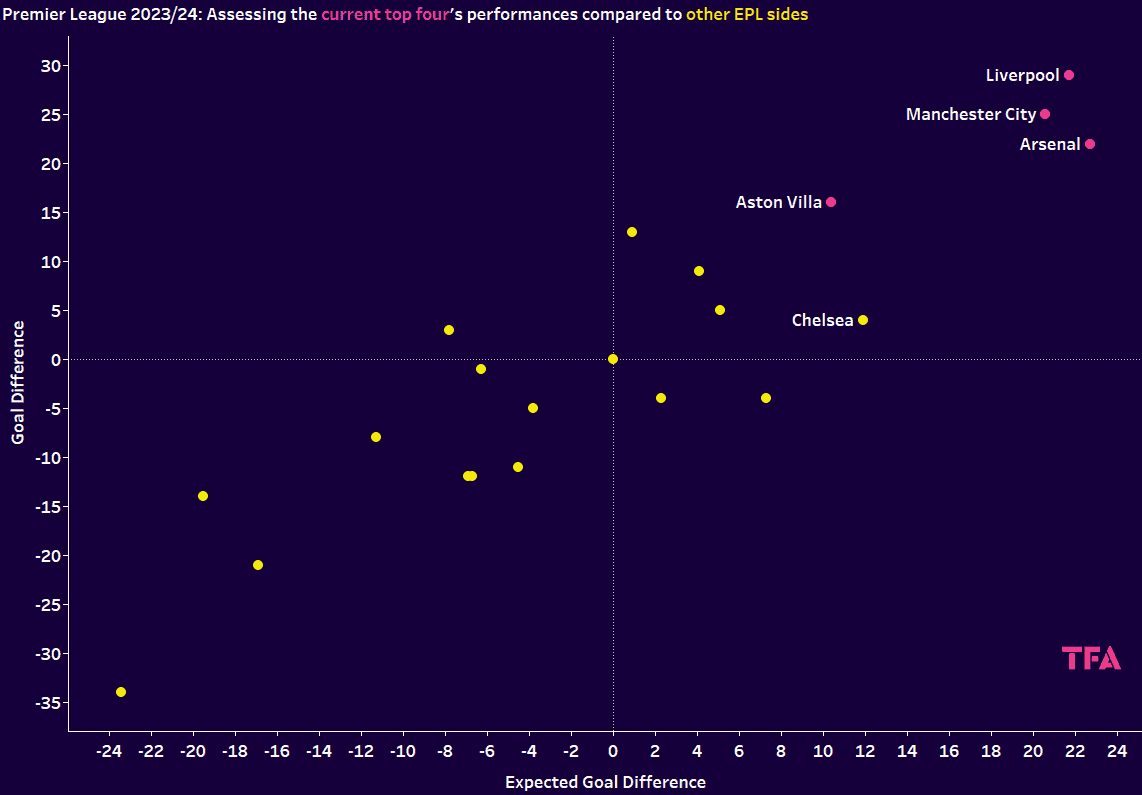
The scatter plot assesses the performance of clubs in the Premier League this season, prior to midweek fixtures, by means of expected goal difference and actual goal difference. Teams situated in the top left quadrant can be considered overachieving, while those in the bottom right underachieving. The teams positioned in the top right and bottom left quadrants are performing as expected.
A look at the above shows that all the top four sides are performing as expected. However, Liverpool and Villa are arguably overachieving the most out of those four sides, considering Klopp’s side’s actual goal difference is 7.3 better than expected. Similarly, Emery’s side’s goal difference is 5.6, which is better than expected. While this could be a product of some exceptional displays from these two teams, you can’t rule out a bit of luck.
Whilst this paints a picture of the top four over the course of the season to date, what about in more recent matches?
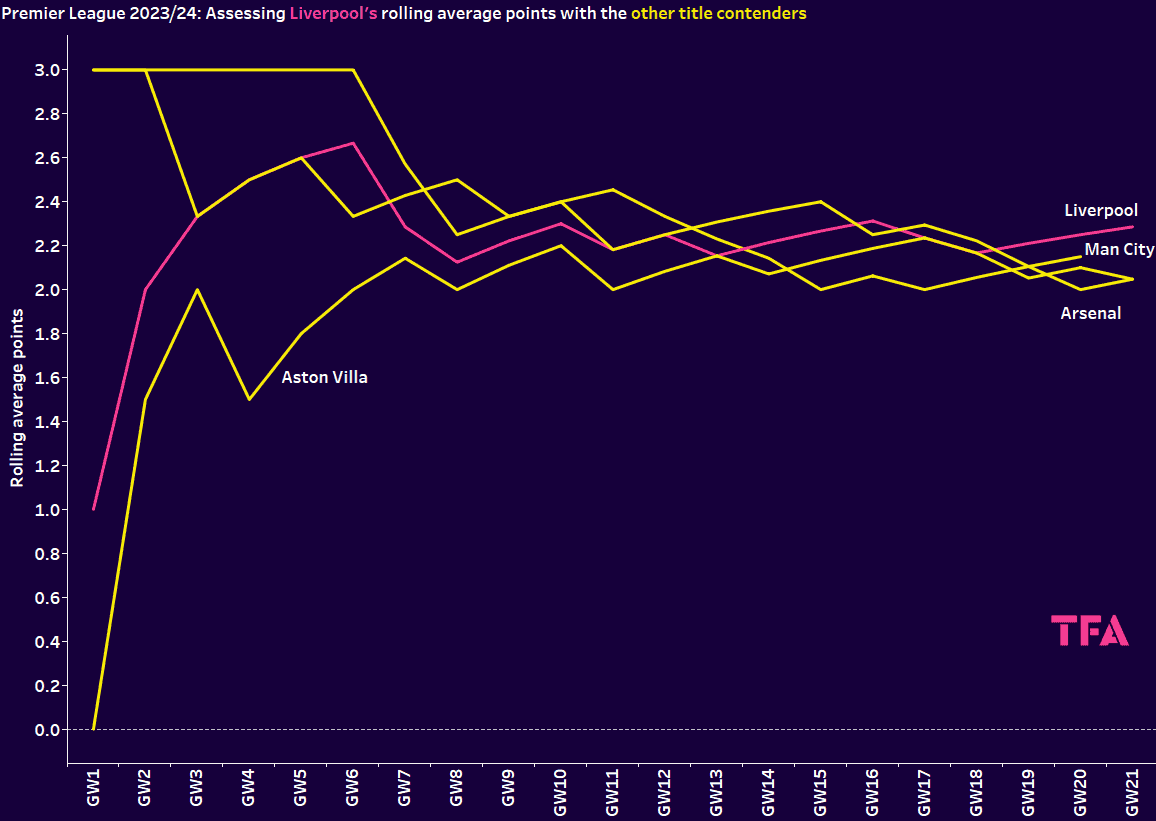
The graph shows that despite City’s unbeaten start to the season, when they won their first six matches, their form declined such that their other three contenders were outperforming the current defending champions at one stage.
Pep Guardiola’s side has been on the up, though, recently. Even though City have a game in hand, they are averaging 2.15 points per game, which is fewer than Liverpool’s 2.29 points per match. The Reds’ current average points per game are equal to the average points per game of all previous title winners since 1993.
With another 17 league matches to play, at the current rate, Liverpool can expect to finish the season on 86 points. However, this tally would have been enough to win the league in only 11 of the 28 seasons where the league has comprised 20 teams. This indicates that as no one team is running away from the pack, the points are more distributed among those at the top.
While Liverpool and City appear on the rise, Arsenal and Villa are seemingly stagnating. Arsenal’s current 2.05 points per match is less than last season when they averaged 2.21 points per game. The fact that the Gunners aren’t at the same level as at the end of last season, when their form dipped, doesn’t bode well.
This analysis already touched on that, as far as Villa is concerned, some luck may be attributed to their current success, and a look at their goal-scoring credentials over the course of the season further suggests a hint of fortune.
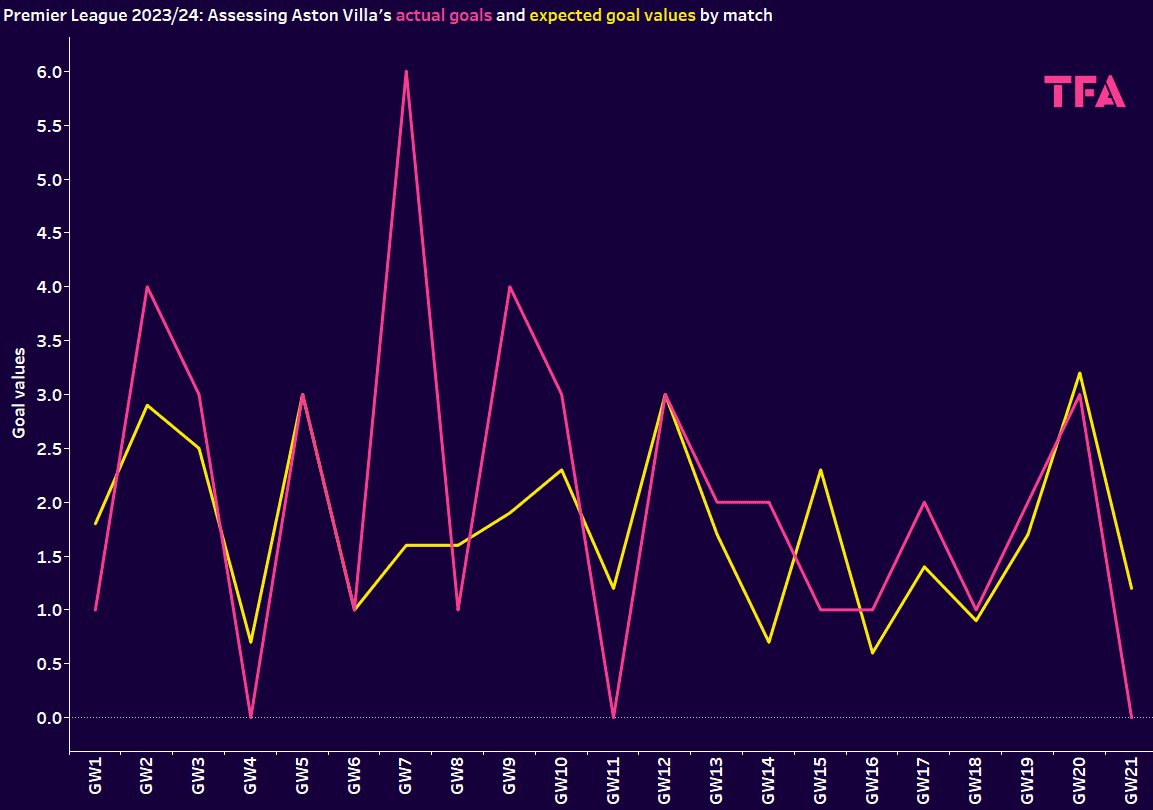
The graph shows Villa’s expected goals, represented in yellow, in each game, as well as their actual goals scored in each game, shown in pink. In the earlier stages of the campaign, Villa were often scoring more than anticipated. They put six past Brighton despite an expected goal tally of just 1.6.
Although they have not been picking up as many points lately, Villa are showing flashes of strong attacking play, exemplified by their recent 3-2 victory over Burnley, where their expected goals tally for that match was 3.2.
This shows their attacking performance warranted the end result in this instance. However, it will be of concern how many goals they have been shipping of late. In their last five league matches, at the time of writing, the Midlands side conceded seven goals, accounting for 26% of their total goals conceded this campaign. Emery’s side will need to find some consistency if they are to be in this title race for the long haul.
Moreover, particularly Villa’s and City’s defensive record over this campaign does not stack up to previous league winners. Of all previous EPL winners, teams have averaged scoring 2.15 goals per match and conceding 0.85 goals per match.

The table shows that although Liverpool and City are outscoring the average goals per match of previous winners, only Liverpool has a defence that is seemingly strong enough to be more in line with a title-winning side. However, it is worth noting that Liverpool has been expected to concede more: 24 goals. Nevertheless, there are signs that the title may be heading back to Anfield.
When the contenders are scoring
With the exception of Aston Villa, all the title contenders have scored the majority of their goals in the final 15 minutes of games, including extra time. Considering the large amount of extra time added on these days, this doesn’t come as too much of a surprise. However, Alex Ferguson’s title-winning United sides over the years were known for late goals.
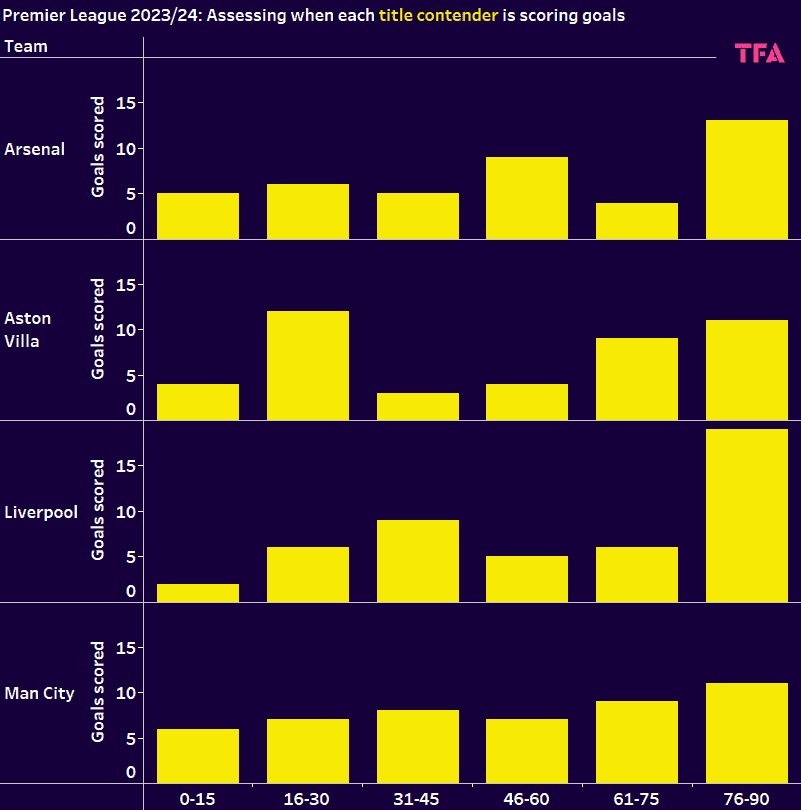
The late goals in the final 15 minutes scored by Liverpool, City, and Arsenal ensure each of these sides are in the top five in the division for goals scored in the closing stages. Liverpool’s ability to score late goals has helped push their title charge. The Merseyside club have gained 15 points from goals in the final 15 minutes. Without these points, they would be below West Ham, occupying sixth place.
Arsenal and Villa aren’t too far behind, as they have gained 9 and 10 points from late goals in the last 15 minutes. Without these points, both sides would sit just above Brighton. City has only gained six points from late goals. City’s general dominant play, as they average 64.1% possession – the highest in the league – as well as their ability to score early goals, suggests they often can get a foothold in matches.
City are the strongest starters of the title contenders, having scored the most and conceded the fewest of the four in the opening 15 minutes of games. If City can take the lead, they don’t lose. From 17 leading positions this season, the outcome has been 13 wins, four draws, and no defeats. Liverpool are also undefeated from winning positions and have only dropped four points from winning positions this season.
Villa are the only team in the division to have dropped fewer points than Klopp’s side from winning positions, as they have recorded 13 wins from 14 matches in which they have taken the lead.
The Midlands side are also equally comfortable fighting back in matches and ranks fourth in the top tier from points gained from losing positions.
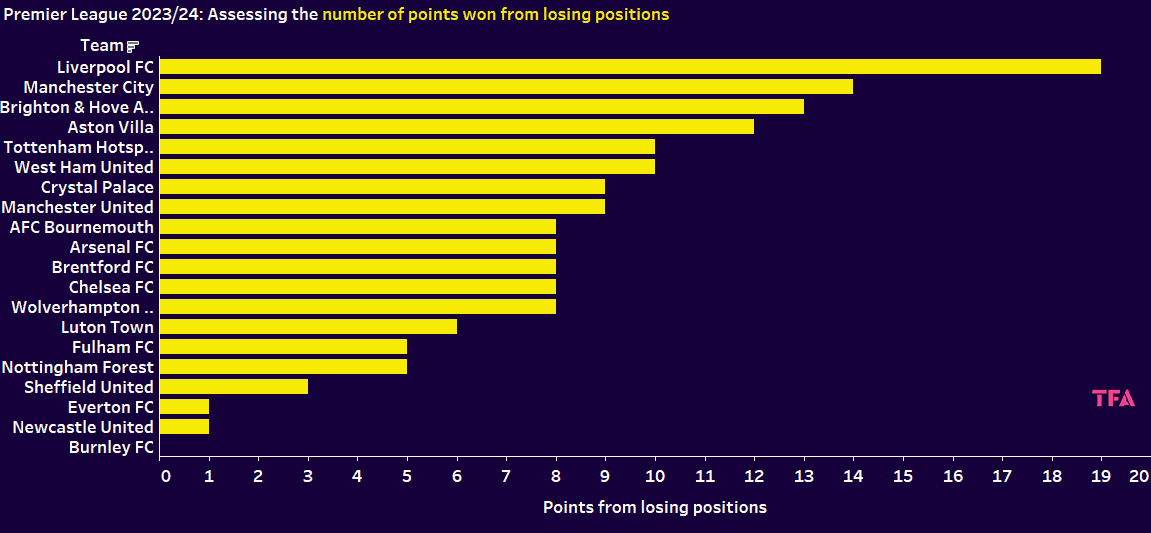
Of the title contenders, Arsenal struggles the most from losing positions, having only won eight points from such positions. This ensures Mikael Arteta’s side lies mid-table for such a statistic; therefore, they may not have the character of champions to fight back. That being said, Arsenal does rank top of the league for goals scored in the first 15 minutes following half-time. This could suggest some motivational team talks at the Emirates.
From the above graph, it is Liverpool, however, who tops the league for points from losing positions this season with 19; City sits second, having won 14 points from deficits. One crucial goal came at the Etihad as Trent Alexander-Arnold’s late strike was enough to snatch a point in Manchester at the expense of rivals City.
As a result, Liverpool are unbeaten against their fellow title contenders, having taken five from a possible nine so far this season. On the other hand, City have only taken one point from nine, ensuring they have taken the least from their title challengers. This may prove the difference in City defending their title.
Moreover, despite not having lost at home this season, City are lagging behind their rivals in terms of points per match at home.
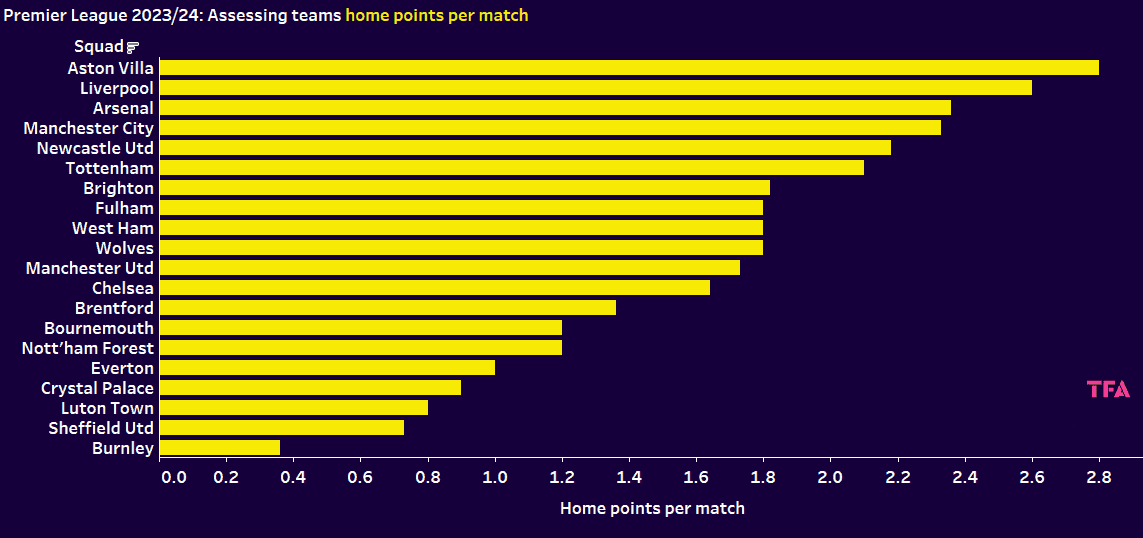
The graph shows that all of City’s rivals occupy the top three places in the league for points per match on home soil this campaign. At the time of writing, both Villa and Liverpool, like City, remain unbeaten at home, while Arsenal has only lost once at the Emirates.
However, it is a different story away from home for Villa.
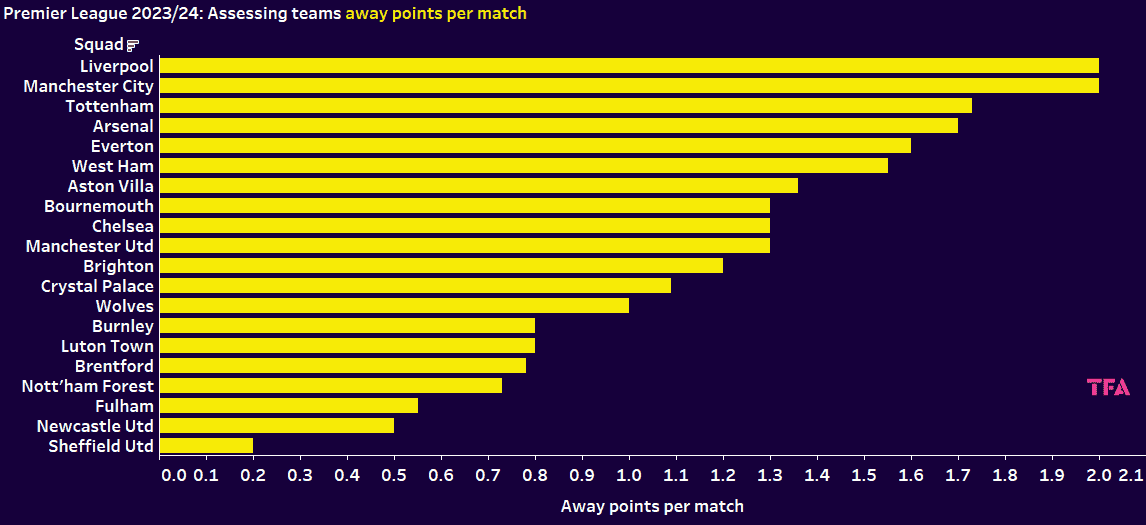
The bar chart shows that Liverpool, City, and Arsenal are within the top four teams for points per match away from home. Villa, in contrast, ranks seventh, having won 1.36 points per match on the road. They will be looking to improve this if they are to keep the pace.
Finding the key players
With 14 league goals apiece and the joint top scorers in the division, it is obvious how important Mo Salah and Erling Haaland are to their team’s title race. The same can be said for Ollie Watkins at Aston Villa, who has scored nine league goals and tops the assist table with Salah, both having assisted eight times. Not too far behind is Arsenal’s Bukayo Saka, who has seven assists this season.
However, these players are expected to be vital in attacking contributions and therefore, for a fairer analysis, we have considered players’ overall contribution to their team’s success. We first looked at the points per match earned by the team from matches in which each of the title contenders players have featured. Only players who have played at least five 90s have been considered.

The bar chart shows that the majority of players who make up the top 10 are in the Liverpool squad, and no Villa player features. Rodri ranks second and it’s no coincidence that in the two games that the midfielder has missed, City suffered back-to-back defeats.
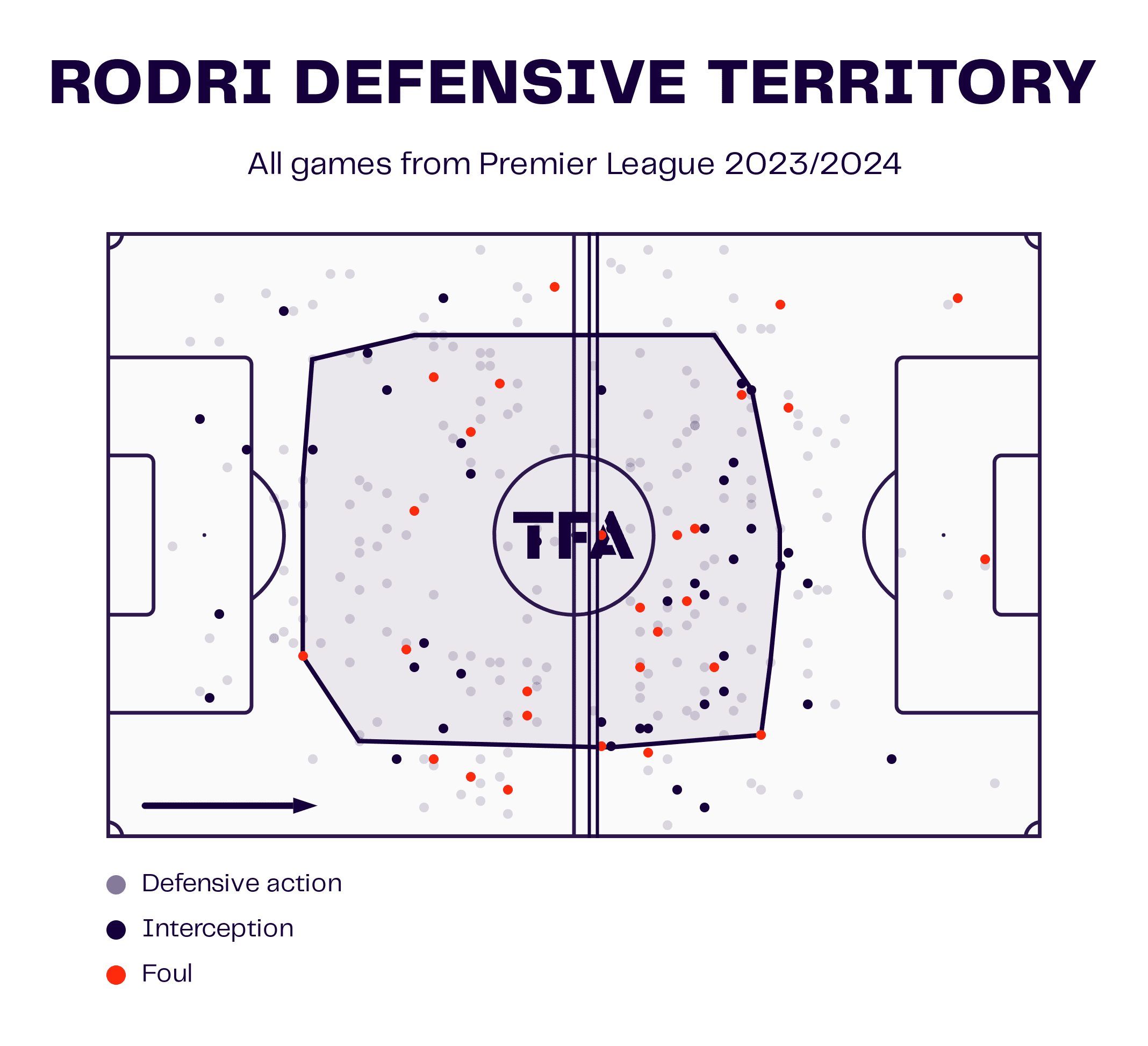
Rodri dominates defensively in the central areas of the pitch as he typically sets up in defensive midfield, linking up with a defensive teammate operating in a hybrid role. The graphic shows that Rodri generally keeps a high defensive line for a deep-lying midfielder and has a knack for frustrating the opposition with fouls just within the City half in the wider areas.
As well as his defensive duties, Rodri ranks in the top one to five per cent for his possessional play compared to other tier-one players. Given City’s possessional dominance, it’s not hard to see how important Rodri is.
It is, however, Arsenal’s Aaron Ramsdale who tops the list, as in the matches the England goalkeeper has played this season, the Gunners have won 2.6 points per game. This is much higher than his goalkeeping rival, David Raya. Arsenal have averaged just 1.88 points per match with the Spaniard in goal.
Ramsdale has conceded 0.8 goals per 90 this campaign, fewer than Raya’s one per 90, and has kept a greater percentage of clean sheets than the Spaniard.
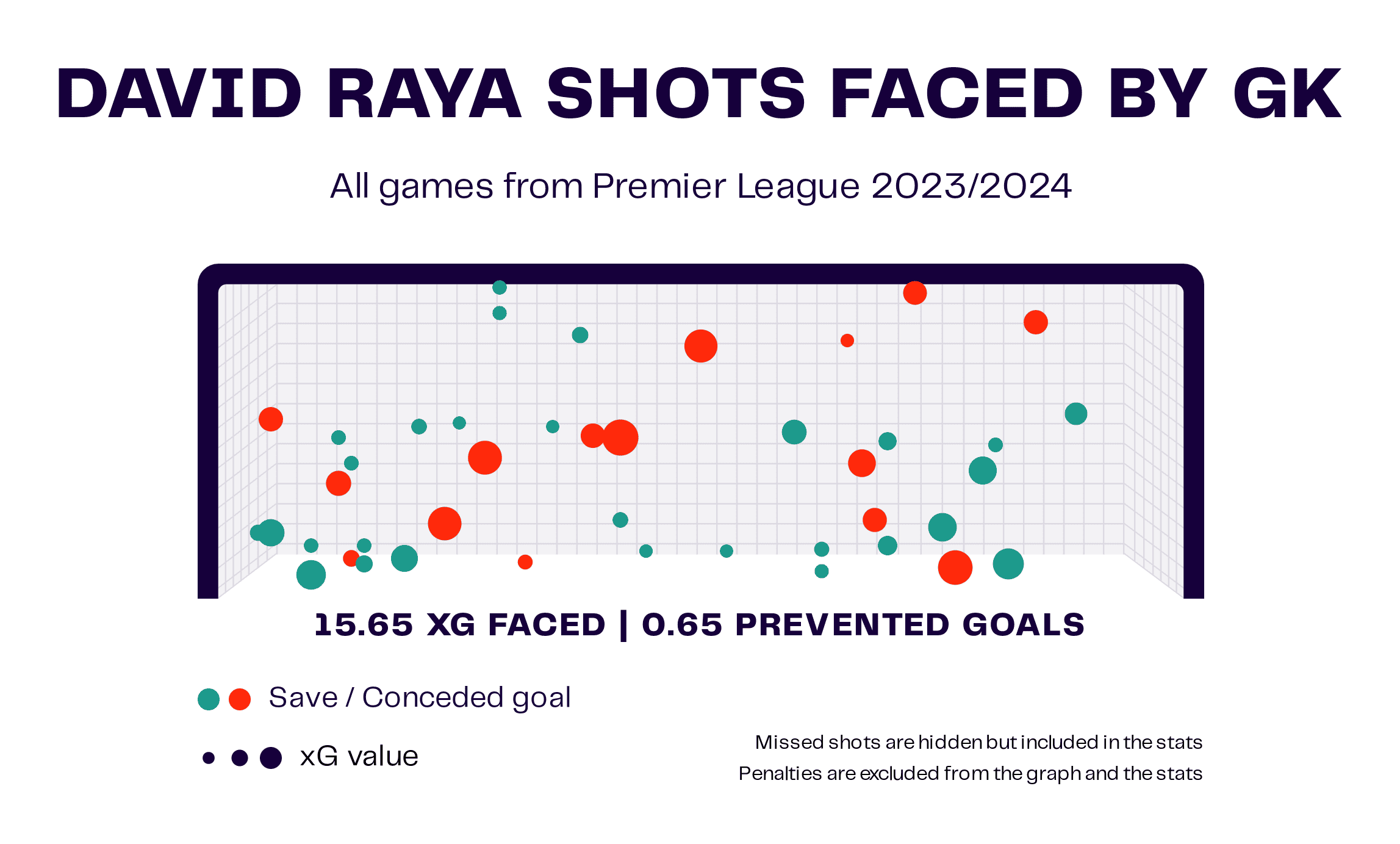
The above graphic shows Raya has been guilty of conceding goals with low goal expectancy values. There is scope that change in the goal line may be the answer for Arsenal to push on in the title race.
We have further assessed the goals scored minus the goals conceded per 90 by teams while each of the contender’s players has been on the pitch.

A host of City and Liverpool players dominate the higher levels of importance, and noticeably for Liverpool fans, Diogo Jota ranks highly. The Reds tend to score 2.14 more goals than they concede per 90 when the Portuguese international is on the pitch. This stands them in good stead, given Salah’s injury and participation in the AFCON.
Liverpool typically sets up in a 4-3-3 formation where Salah is deployed on the right, and he will often look to invert onto this favoured left foot. Jota, in comparison, is more versatile in the respect he has been known to occupy any position across the attacking three.
Salah is undoubtedly a driving force in Liverpool’s attack as he ranks in the top three for shot-creating actions per 90 as well as non-penalty expected goals per 90. This suggests his strong ability to find himself in good goal-scoring opportunities.
However, Jota is more efficient than the Egyptian and is the most efficient forward in the Liverpool ranks, having converted 27% of his shots. Moreover, only Ryan Gravenberch has completed a greater percentage of long passes than Jota at Anfield, demonstrating the former Wolves man’s composure on the ball and ability to pick out a pass.
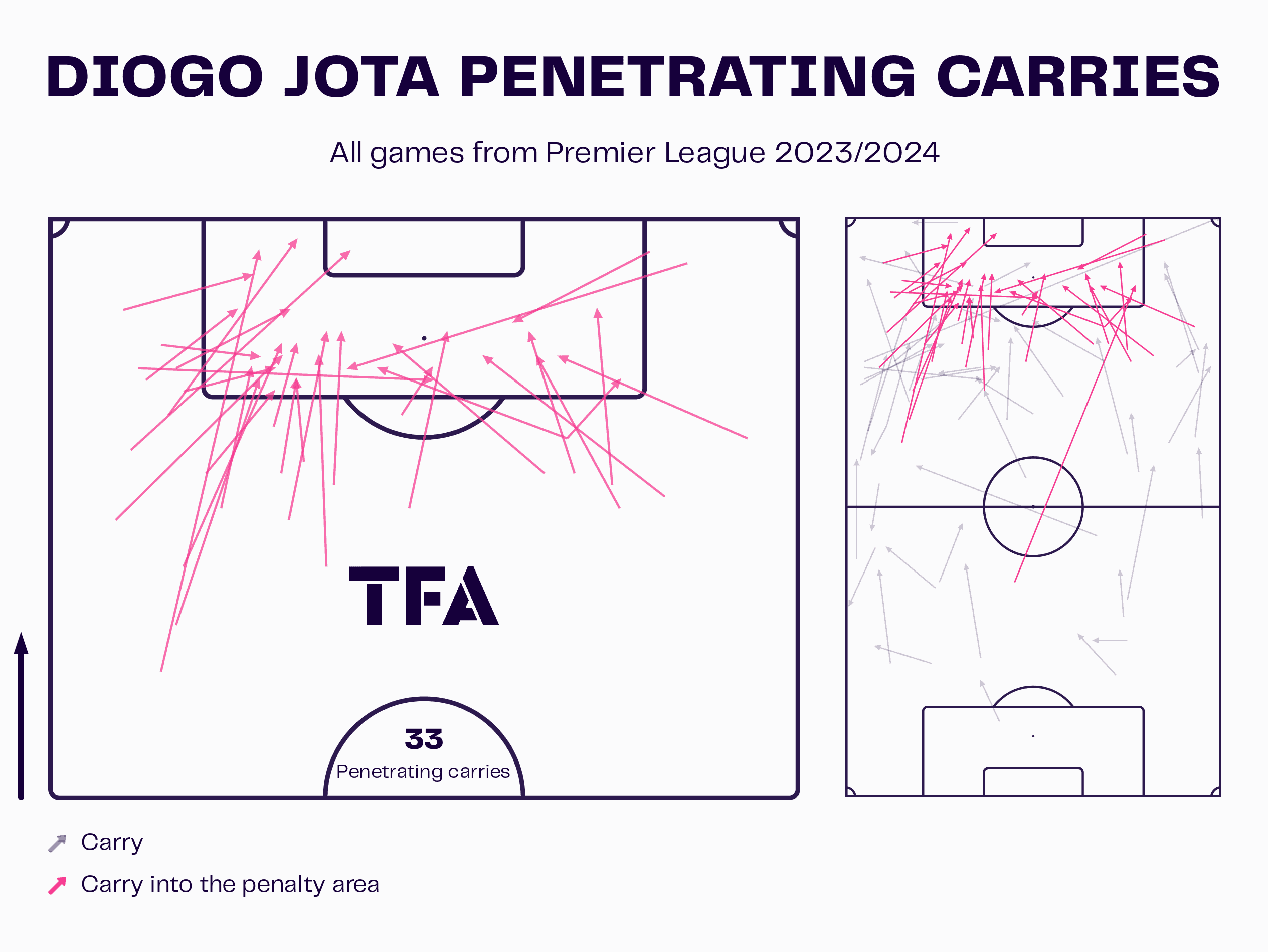
Whilst Salah is a strong carrier of the ball, often driving into the penalty area, Jota has outperformed his teammate per 90 for carries overall and into the final third. A look at the graphic above shows Jota’s carries over the season, and it is noticeable he is strong, driving possession away from his own half as well as into the box from all angles.
With two goals in the recent fixture against Bournemouth, Jota showed how important he is to Liverpool. In Salah’s absence, he will likely be a key player in determining whether the trophy returns to Merseyside.
Of course, one player who has not been mentioned so far due to being out injured for the majority of the campaign is Kevin De Bruyne. The Belgian returned for a brief cameo from the bench against Newcastle and was pivotal in clinching all three points for his side.
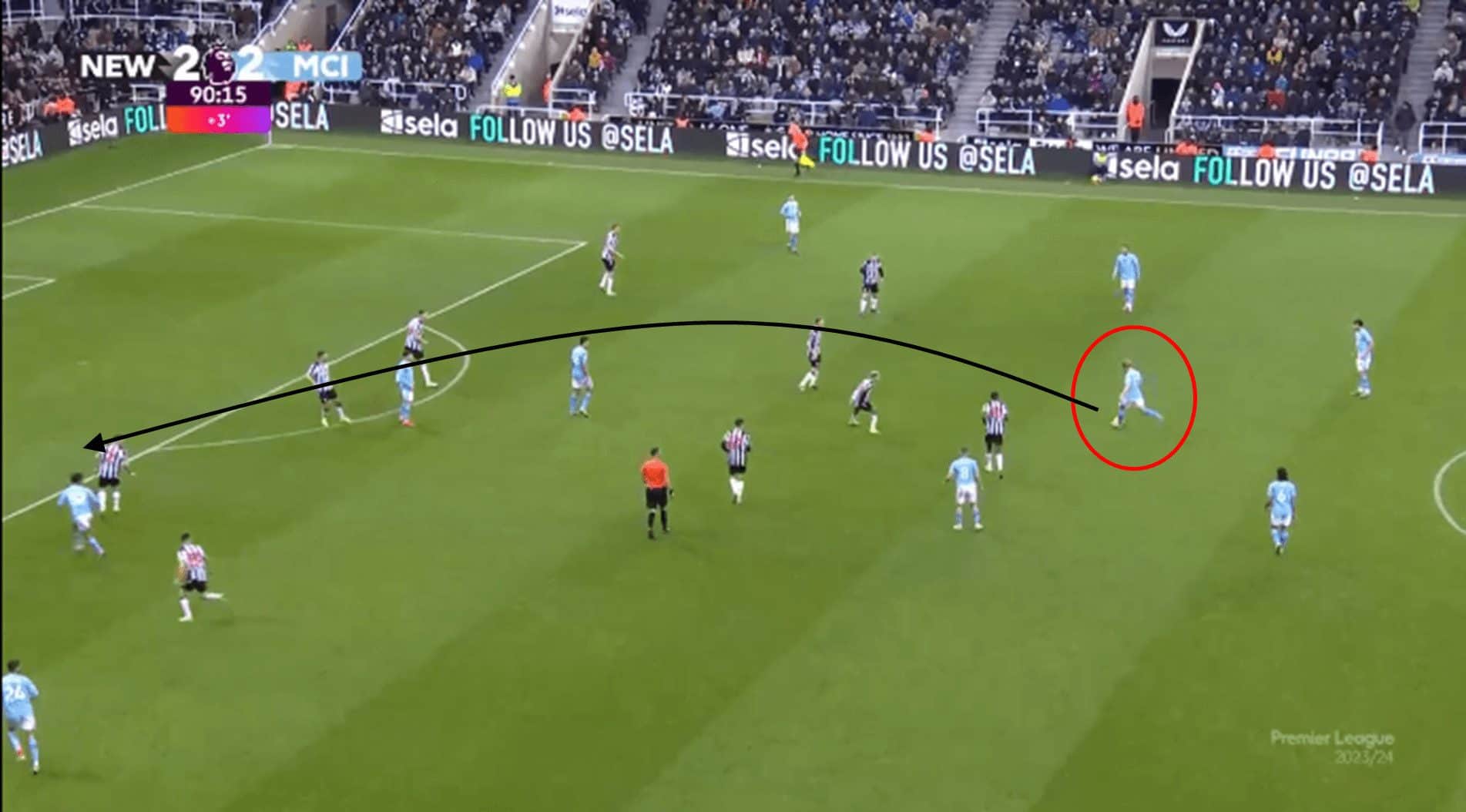
Any player who can assist with such precision, as above, in the dying moments of a match certainly warrants a mention as a key figure. De Bruyne isn’t the only player working back from the sidelines in the City ranks, though; undoubtedly, their close rivals will be fully aware. The previous title races have shown that near perfection is what it can take to displace Guardiola’s side at times.
Conclusion
In this data analysis, we have shown that Villa have ridden their luck at times over the season but are still a strong side at home. We have also shown that Arsenal are not as strong in coming back in matches, and a change of goalkeeper may be a solution going forward; City are surprisingly poor against their contenders but have key players returning.
And speaking of key players, Jota is likely to be key in Salah’s absence. If Liverpool can keep up their strong defensive displays and continue to grind out results, could the trophy be heading to Anfield for a second time? Time will tell, but if past seasons are anything to go by, you can’t rule out the unexpected.






Comments